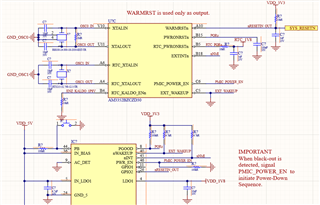Other Parts Discussed in Thread: TPS65218D0, TPS65218
We are trying to use the TPS65216DO to power the AMC335x. We are a bit confused on the RTC-only mode power connections. We are following the directions in the TPS65216 User Guide Figure 5 and per the directions we are replacing the LDO1 with an always-on LDO per the attached schematic (connecting VDDS_RTC and RTC_PWRONRSTn to the LDO OUT pin). Additionally the other connections in figure 5 are also made (EXTWAKEUP at AM335x is connected to nWAKEUP at TPS65216, RTC_KALDO_ENn and CAP_VDD_RTC are connected as shown). This will allow use to use the DCDC4 (3.3V) voltage rail when mains power is available and replace that with the coin-cell battery backup supply when mains power is off. What we would like to know is the following:
- Does this approach look correct? Is there anything we may be missing to use the RTC-Only Mode?
- What would be the current pull from the coin-cell in RTC-Only Mode in this approach? So we can size the coin-cell battery appropriately.
A related issue is this; Can you estimate the accuracy of the internal RC oscillator? Our application is not super time critical. For time keeping purposes, couple of seconds of inaccuracy per day is not a huge problem, so we would like to know if we really need an external 32K oscillator or AM335x's internal oscillator is adequate for our application.




